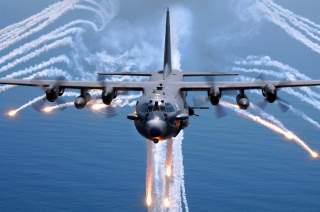If You See This in the Sky It Means You're Dead: Why AC-130 Gunships Rule
A classic killer.
The AC-130 gunship (in its various versions) is a heavily armed aircraft incorporating side-firing weapons integrated with sophisticated sensor, navigation, and fire control systems to provide surgical firepower or area saturation during extended loiter periods, at night and in adverse weather. The sensor suite consists of a multispectral television sensors, high definition infrared sensors, and radar. These sensors allow the gunship to visually or electronically identify friendly ground forces and targets anytime, anywhere.
AC-130 primary missions are close air support (CAS), air interdiction (AI) and armed reconnaissance. CAS missions include troops in contact (TIC), convoy escort and point air defense. AI missions are conducted against preplanned targets or targets of opportunity and include strike coordination, reconnaissance, and armed overwatch mission sets.
During Operation Desert Storm (ODS), U.S. Air Force (USAF) AC-130s performed mainly CAS and force protection (air base defense) for ground forces.
As reported by Paul H. Larson, Headquarters Air Force Reserve Command History Office in the article The Ghost Over the Highway: Reservists renew bond with Desert Storm AC-130A gunship, on Feb. 26, 1991, Capt. Richard S. “Beef” Haddad, and 1st Lt. Randal L. Bright, – both members of the 711th Special Operations Squadron (SOS) at Duke Field, Florida – were assigned to a mission over a road connecting Kuwait City to Baghdad. In Aug. of the previous year, Iraqi soldiers had invaded Kuwait, sparking a chain of events that soon led to the U.S. sending military members to Saudi Arabia as part of Operation Desert Shield/Storm. The 711th SOS was part of these operations. The road was crowded with Iraqi military vehicles exiting Kuwait and going back to Iraq.
Two other reservists, Maj. Michael N. Wilson and Maj. Clay McCutchan, piloted the lead AC-130 as the 711th SOS raced to stop Iraqi forces fleeing from Kuwait to Iraq. Wilson and McCutchan determined that they did not have enough fuel to successfully execute the mission. As a result, they radioed Haddad and implored him to “hurry up” and “get up here.”
While en route, Haddad noticed that his aircraft’s autopilot feature was not working. Without the autopilot, Haddad and his co-pilot, Bright, faced a greater challenge than they had anticipated because they relied upon the autopilot’s altitude-hold function to keep the aircraft at a fixed altitude while they banked and fired the gunship’s weapons.
To compensate, Haddad had to manually control the ailerons to turn the aircraft while also firing the guns. Bright, facing an equally challenging task, crouched down in his seat in order to work the aircraft’s throttles and yoke simultaneously to maintain a fixed altitude. Working in tandem to complete the mission, Haddad, Bright and the rest of the reservists aboard the aircraft remained on station, firing their weapons with little resistance – a situation that quickly changed.
As they began to leave the “killbox,” Haddad and company discovered that their efforts had not gone unnoticed. As they headed south, Master Sgt. Don Dew, the illuminator operator, excitedly yelled “missile launch” over the radio. In response, Haddad increased power and put the aircraft in a dive while Capt. Jose Davidson, the aircraft’s navigator, released flares to counter the missile. Unaware of the navigator’s actions, Haddad and Bright, hearing the noise and seeing the light produced by the flare, believed their aircraft had been hit.
“My hands were gripping the throttles, thinking we were going down,” Haddad said.
After seeing more flashes, Haddad and Bright realized that they were in no danger.
The significance of the mission they participated in that night was not immediately apparent to Haddad and his crew. However, the stretch of road that they had fired on quickly became known as the “Highway of Death” due to the enormity of the destruction caused that night.
While the exact number of casualties remains unknown, the attack destroyed an estimated 1,400 to 2,000 vehicles. Haddad, Bright and the crew destroyed at least 20 enemy trucks and four armored personnel carriers. They received the Air Medal for their actions that night.
On Jun. 12, 2014, more than 20 years after ODS, Richard S. “Beef” Haddad, now Major General, and Randal L. Bright, Colonel, boarded the AC-130A Spectre gunship – No. 55-0014 – at the Museum of Aviation at Robins Air Force Base, Georgia, where the aircraft is on display for the public to see.
The aircraft was the same that took them over the “Highway of Death” that night.
Haddad, who now serves as vice commander of Air Force Reserve Command (AFRC), and Bright, Commander of the 927th Air Refueling Wing, MacDill AFB, Fla, reflected on that eventful night in early 1991.
“It was an exciting time for me and the other members of my crew,” Haddad said in the Aug. 2014 edition of Citizen Airman. “That experience helped me go to war in the future as we went to Operation Iraqi Freedom (OIF) and Operation Enduring Freedom (OEF). It helped in terms of realizing the risks and what it was like to be a crew member going into that kind of environment.”
Like Haddad, Bright maintained that the night had a lasting impact on him and his career because it “was always something I could hang my hat on. As a youngster in the Air Force, I had seen combat.”
This first appeared in Aviation Geek Club here.

